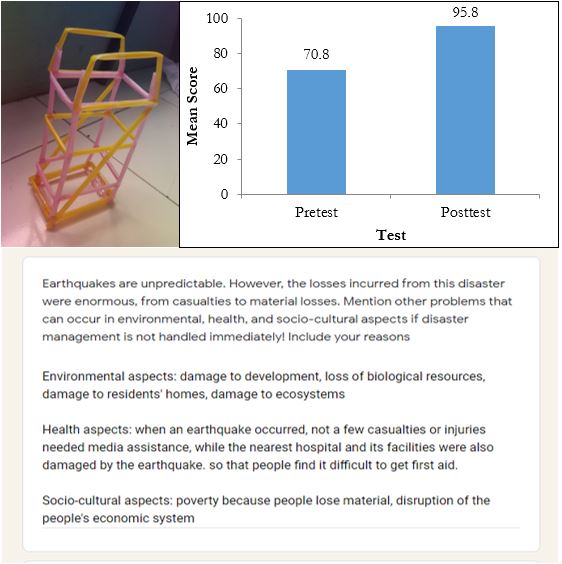
Promoting Student's Problem-Solving Skills through STEM Project-Based Learning in Earth Layer and Disasters Topic
Abstract
Full Text:
DOWNLOAD PDFReferences
Apriyani, R., Ramalis, T. R., & Suwarma, I. R. (2019). Analyzing Student's Problem Solving Abilities of Direct Current Electricity in STEM-based Learning. Journal of Science Learning, 2(3), 85–91. https://doi.org/10.17509/jsl.v2i3.17559
Arisanti, W. O. L., Sopandi, W., & Widodo, A. (2016). Analisis Penguasaan Konsep dan Keterampilan Berpikir Kreatif Siswa SD Melalui Project Based Learning. EduHumaniora|Jurnal Pendidikan Dasar Kampus Cibiru, 8(1), 82-95.
Arreola, N. J., & Reiter-Palmon, R. (2016). The effect of problem construction creativity on solution creativity across multiple everyday problems. Psychology of Aesthetics, Creativity, and the Arts, 10(3), 287–295. https://doi.org/10.1037/a0040389
BNPB. (2020). Data Informasi Bencana Indonesia (DIBI). Retrieved from https://bnpb.cloud/dibi/
Benedek, M., Nordtvedt, N., Jauk, E., Koschmieder, C., Pretsch, J., Krammer, G., & Neubauer, A. C. (2016). Assessment of creativity evaluation skills: A psychometric investigation in prospective teachers. Thinking Skills and Creativity, 21, 75–84. https://doi.org/10.1016/j.tsc.2016.05.007
Bhakti, Y. B., Astuti, I. A. D., Okyranida, I. Y., Asih, D. A. S., Marhento, G., Leonard, L., & Yusro, A. C. (2020). Integrated STEM Project Based Learning Implementation to Improve Student Science Process Skills. Journal of Physics: Conference Series, 1464(1). https://doi.org/10.1088/1742-6596/1464/1/012016
BigRentz. (2020). How Earthquake-Proof Buildings Are Designed. Retrieved from https://www.bigrentz.com/blog/earthquake-proof-buildings
Capraro, M. M., & Jones, M. (2013). Interdisciplinary STEM project-based learning. STEM Project-Based Learning an Integrated Science, Technology, Engineering, and Mathematics (STEM) Approach, 51–58. https://doi.org/10.1007/978-94-6209-143-6_6
Chang, C. Y., & Weng, Y. H. (2002). An exploratory study on students' problem-solving ability in earth science. International Journal of Science Education, 24(5), 441–451. https://doi.org/10.1080/09500690110066502
CNN Indonesia. (2019). BMKG: Jepang Sudah Wajibkan Bangunan Anti Gempa Sejak 1990. Retrieved from https://www.cnnindonesia.com/teknologi/20191003112012-199-436323/bmkg-jepang-sudah-wajibkan-bangunan-anti-gempa-sejak-1990
Cropley, A. (2006). In praise of convergent thinking. Creativity Research Journal, 18(3), 391-404.
Deniz, M. (2004). Investigation of the Relation between Decision Making Self-Esteem, Decision Making Style and Problem Solving Skills of University Students. Eurasian Journal of Educational Research (EJER), (15).
Earthquake Track. (2020). Recent Earthquakes Near Indonesia. Retrieved from https://earthquaketrack.com/p/indonesia/recent
Gustiani, I., Widodo, A., & Suwarma, I. R. (2017). Development and validation of science, technology, engineering and mathematics (STEM) based instructional material. In AIP Conference Proceedings (Vol. 1848, No. 1, p. 060001). AIP Publishing LLC.. https://doi.org/10.1063/1.4983969
Guthrie, J. T., Schafer, W. D., Von Secker, C., & Alban, T. (2000). Contributions of instructional practices to reading achievement in a statewide improvement program. Journal of Educational Research, 93(4), 211–225. https://doi.org/10.1080/00220670009598710
Grohman, M., Wodniecka, Z., & Kłusak, M. (2006). Divergent thinking and evaluation skills: Do they always go together?. Journal of Creative Behavior, 40(2), 125–145.
Hake, R. R. (1998). Interactive-engagement versus traditional methods: A six-thousand-student survey of mechanics test data for introductory physics courses. American Journal of Physics, 66(1), 64-74. https://doi.org/10.1119/1.18809
Hanif, S., Wijaya, A. F. C., & Winarno, N. (2019). Enhancing Students' Creativity through STEM Project-Based Learning. Journal of Science Learning, 2(2), 50. https://doi.org/10.17509/jsl.v2i2.13271
Henderson, C. (2005). Strategies for the Development of Student Problem Solving Skills in the High School Physics Classroom. Am. J. Physics, 59(10), 891-897.
Heffernan, K., & Teufel, S. (2018). Identifying problems and solutions in scientific text. Scientometrics, 116(2), 1367–1382. https://doi.org/10.1007/s11192-018-2718-6
Jua, S. K. , Sarwanto, & Sukarmin. (2018). The profile of students' problem-solving skill in physics across interest program in the secondary school. In Journal of Physics: Conference Series (Vol. 1022, No. 1, p. 012027). IOP Publishing.
Lou, S. J., Chou, Y. C., Shih, R. C., & Chung, C. C. (2017). A study of creativity in CaC 2 steamship-derived STEM project-based learning. Eurasia Journal of Mathematics, Science and Technology Education, 13(6), 2387–2404. https://doi.org/10.12973/EURASIA.2017.01231A
Maydeu-Olivares, A., & D'Zurilla, T. J. (1997). The factor structure of the problem solving inventory. European Journal of Psychological Assessment, 13(3), 206–215. https://doi.org/10.1027/1015-5759.13.3.206
Nuraziza, R., & Suwarma, I. R. (2018). Menggali Keterampilan Creative Problem Solving Yang Dimiliki Siswa SMP Melalui Pembelajaran IPA Berbasis STEM [Exploring the Creative Problem Solving Skills of Junior High School Students Through STEM-Based Science Learning]. WaPFi (Wahana Pendidikan Fisika), 3(1), 55. https://doi.org/10.17509/wapfi.v3i1.10941
Netwong, T. (2018). Development of Problem Solving Skills by Integration Learning Following STEM Education for Higher Education. International Journal of Information and Education Technology, 8(9), 639–643. https://doi.org/10.18178/ijiet.2018.8.9.1114
OECD. (2019). PISA 2018 Results: Combined Executive Summaries, Volume I, II & III. Retrieved from https://www.oecd.org/pisa/Combined_Executive_Summaries_PISA_2018.pdf
Osborn, A. F. (1963). Applied imagination; principles and procedures of creative problem-solving. Scribner.
Schlegel, R. J., Chu, S. L., Chen, K., Deuermeyer, E., Christy, A. G., & Quek, F. (2019). Making in the classroom: Longitudinal evidence of increases in self-efficacy and STEM possible selves over time. Computers & Education, 142, 103637. https://doi.org/10.1016/j.compedu.2019.103637
Tseng, K. H., Chang, C. C., Lou, S. J., & Chen, W. P. (2013). Attitudes towards science, technology, engineering and mathematics (STEM) in a project-based learning (PjBL) environment. International Journal of Technology and Design Education, 23(1), 87-102 https://doi.org/10.1007/s10798-011-9160-x
Treffinger, D. J., Isaksen, S. G., & Stead-Dorval, K. B. (2005). Creative problem solving: An introduction. Prufrock Press Inc.
Whitten, S., & Graesser, A. C. (2003). Comprehension of text in problem solving. In J. E. Davidson & R. J. Sternberg (Eds.), The psychology of problem solving (pp. 207–229). New York, NY: Cambridge University Press.
Yuliati, L., Riantoni, C., & Mufti, N. (2018). Problem solving skills on direct current electricity through inquiry-based learning with PhET simulations. International Journal of Instruction, 11(4), 123–138. https://doi.org/10.12973/iji.2018.1149a
DOI: https://doi.org/10.17509/jsl.v4i3.27555
Refbacks
- There are currently no refbacks.
Copyright (c) 2021 Firdha Sarah Kartini, Ari Widodo, Nanang Winarno, Yustika Sya'bandani

This work is licensed under a Creative Commons Attribution-ShareAlike 4.0 International License.


Jl. Dr. Setiabudhi 229 Bandung 40154, West Java, Indonesia











